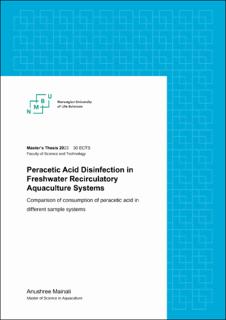| dc.description.abstract | Peracetic acid (PAA), a powerful organic peroxide, is regarded as a rather sustainable disinfectant in aquaculture due to its broad efficacy against various pathogens at low concentrations. PAA-based disinfectants are highly regarded in recirculating aquaculture systems (RAS) due to their low risk of bioaccumulation, rapid degradation with neutral residuals, and minimal impact on biofilter performance. However, the unknown no-observed-effect concentration in Atlantic salmon parr remains a concern.
In this study, it is attempted to investigate the decay kinetics of PAA as a disinfecting agent in aquaculture by comparing the consumption of PAA across the analysed samples at two temperatures. The consumption of PAA in two types of sample systems; a. PAA-adapted and PAA-naive RAS water samples, and b. samples with seven levels of feed loads were studied and compared. The effect of PAA treatment on the water quality parameters of TSS, COD and turbidity at two temperatures 12°C and 15°C were quantified and compared as well.
Regardless of the treatment temperature, PAA decayed more rapidly in PAA-adapted RAS water samples compared to PAA-naive samples. Higher PAA decay was observed in samples with higher feed loads. Furthermore, PAA treatment resulted in an increase in COD and a significant decrease in TSS and turbidity. The results indicated that the treatment temperature shows a positive temperature-decay correlation for PAA, this was majorly due to the comparatively rapid consumption of PAA immediately after the treatment at 15°C than at 12°C. The effect of temperature on water quality parameters was considerable, with higher temperatures resulting in more significant changes. In summary, the findings of the study can aid in supporting the pulse application of PAA in freshwater RAS because of its implications of an adapted sample system. It also elucidates the contribution of treatment temperature and feed loads in PAA decay. | |
